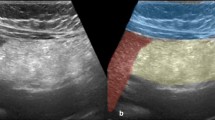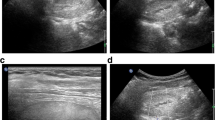Abstract
The segmental omental infarction is a rare self-limited disorder presenting with aspecific clinical symptoms that may mimic several acute abdominal conditions. Therefore, a correct noninvasive diagnosis is important because treatment approaches range from monitoring to surgery. As omental infarction results in an important fat stranding that is much greater than the degree of bowel wall thickening, it suggests a narrower differential diagnosis: appendicitis, diverticulitis, epiploic appendagitis, and mesenteric panniculitis. In this pictorial essay, we point out the importance of imaging in identifying this typical sign allowing alternate diagnoses such as segmental omental infarction that can be conservatively managed.







Similar content being viewed by others
References
Cianci R, Filippone A, Basilico R et al (2008) Idiopathic segmental infarction of the greater omentum diagnosed by unenhanced multidetector-row CT and treated successfully by laparoscopy. Emerg Radiol 15:51–56
Kamaya A, Federle MP, Desser TS (2011) Imaging manifestations of abdominal fat necrosis and its mimics. RadioGraphics 31:2021–2034
Walia R, Verma R, Copeland N et al (2014) Omental infarction: an unusual cause of left-sided abdominal pain. ACG Case Rep J 1(4):223–224
Rao A, Remer EM, Phelan M et al (2007) Segmental omental infarction. Emerg Radiol 14:195–197
AbdulAziz A, El Zalabany T, Al Sayed AR et al (2013) Idiopathic omental infarction, diagnosed and managed laparoscopically: a case report. Hindawi Publishing Corporation Case Reports in Surgery, Article ID, 193546
Wang W, Wang ZJ, Webb EM et al (2013) Omental infarction preceded by anatomically upturned omentum. Clin Imaging 37(6):1125–7
Ryan J, Simpson P, McLaughlin S (2013) Education and imaging: gastrointestinal: omental infarction. J Gastroenterol Hepatol 28(2):378
Lubner MG, Simard ML, Peterson CM et al (2013) Emergent and nonemergent nonbowel torsion: spectrum of imaging and clinical findings. Radiographics 33(1):155–73
Applegate KE, Sivit CJ, Myers MT et al (2001) (2001) Using helical CT to diagnosis acute appendicitis in children: spectrum of findings. AJR Am J Roentgenol 176:501–505
Bd P, Lawrence EM, Pickhardt PJ (2012) Alternative diagnoses to suspected appendicitis at CT. Radiology 265(3):733–742
Heller MT, Hattoum A (2012) Imaging of acute right lower quadrant abdominal pain: differential diagnoses beyond appendicitis. Emerg Radiol 19:61–73
van Breda Vriesman AC, Puylaert JBCM (2002) Epiploic appendagitis and omental infarction: pitfalls and look-alikes. Abdom Imaging 27:20–28
Blinder E, Ledbetter S, Rybicki F (2002) Primary epiploic appendagitis. Emerg Radiol 9:231–233
Daskalogiannaki M, Voloudaki A, Prassopoulos P et al (2000) CT evaluation of mesenteric panniculitis: prevalence and associated diseases. AJR 174:427–431
Conflict of interest
The authors declare that they have no conflict of interest.
Author information
Authors and Affiliations
Corresponding author
Rights and permissions
About this article
Cite this article
Tonerini, M., Calcagni, F., Lorenzi, S. et al. Omental infarction and its mimics: imaging features of acute abdominal conditions presenting with fat stranding greater than the degree of bowel wall thickening. Emerg Radiol 22, 431–436 (2015). https://doi.org/10.1007/s10140-015-1302-0
Received:
Accepted:
Published:
Issue Date:
DOI: https://doi.org/10.1007/s10140-015-1302-0




